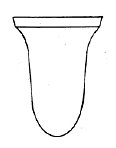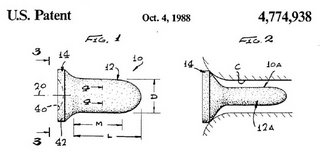Citable No. 36: TTAB Deems Earplug Configuration Functional Based on Expired Patent
Applicant's expired utility patent provided strong evidence of the functionality of the configuration shown immediately below, which Howard Leight sought to register as a trademark for "earplugs for noise protection formed of slow recovery resilient foam material." According to the application, "[t]he mark consists of a bullet-shaped earplug with a vertical axis, a rounded bottom, and a radially outwardly flared top." The Board affirmed refusals to register on the grounds of functionality (Section 2(e)(5)) and, alternatively, lack of distinctiveness. In re Howard Leight Indus., LLC, 80 USPQ2d 1507 (TTAB 2006).

The Board applied the CAFC's Morton-Norwich factors, with an eye on the Supreme Court's TrafFix functionality test. The first factor, the existence of a utility patent disclosing the utilitarian advantages of the design, was dispositive.
The Board ruled that the entirety of the patent, its specification and claims, are relevant to the functionality analysis. Here, Applicant's expired utility patent, entitled "Slow Recovery Earplug with Largely Impenetrable Surface," specifically disclosed and claimed "the functional advantages of the shape of the earplug." The cylindrical shape "allows the body of the earplug to directly contact the surface of the human ear canal, which likewise is cylindrical in shape." The flanged or flared rear end of the earplug "reduces the possibility of deep insertion into the ear, and it reduces the difficulty of removing the earplug."
"These features are more that merely de facto functional; rather, the patent shows that the earplug is in this shape because it works better in this shape. Both the disclosures and the claims of the patent reveal that the shape of the earplug is not a mere arbitrary, ornamental or incidental flourish, but rather serves an essential function in the use of the earplug, and affects the quality of the earplug."
Thus the first Morton-Norwich factor "weighs heavily in favor of a finding of functionality."

The second and fourth factors were neutral, since there was no evidence that Applicant touts the utilitarian advantages of the design in its advertising, nor was there evidence that the design results in a comparatively simple or cheap method of manufacture.
The third factor, the availability of alternative designs, was unimportant because the expired patent alone was a sufficient basis for finding functionality. Consequently, there was "no need to consider the availability of alternative designs, because the feature cannot be given trade dress protection merely because there are alternative designs available." Valu Engineering Inc. v. Rexnord Corp., 61 USPQ2d 1422, 1426 (Fed. Cir. 2002).
Moreover, the Board observed that even if it considered the alternative designs made of record (see photo below), that evidence was insufficient to overcome the patent evidence, "giving due weight to the patent as required by TrafFix." In any case, the alternative designs show that "Applicant's earplug shape clearly is one of but few possible alternative designs" that provide the features and functions of the subject design.

The Board concluded that the evidence "establishes, prima facie, that applicant's design is functional, and that applicant has failed to rebut that presumption."
Next, assuming arguendo that the design is not functional, the Board considered Applicant's Section 2(f) acquired distinctiveness argument. Applicant claimed fifteen years' of use, more than one billion earplugs sold, and advertising expenditures of $1.5 million over the past three years. Not sufficient, said the Board. Fifteen years of exclusive use is not, by itself, enough. Moreover, Applicant's sales figure were not placed in context as to the size of the market, and in any case this evidence does not show that customers recognize the shape as a trademark. As to Applicant's advertising, nothing directs the purchaser to "look for" the shape of the earplugs as a source indicator.
In sum, Applicant failed to establish that its design, even if it were not functional, had acquired distinctiveness.

TTABlog comment: Judge Grendel's opinions are typically well-researched and well-written. His discussion of the interplay of the Morton-Norwich factors and the TrafFix test is particularly noteworthy.
Text Copyright John L. Welch 2006.




0 Comments:
Post a Comment
<< Home